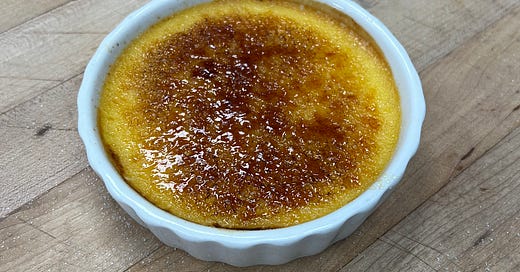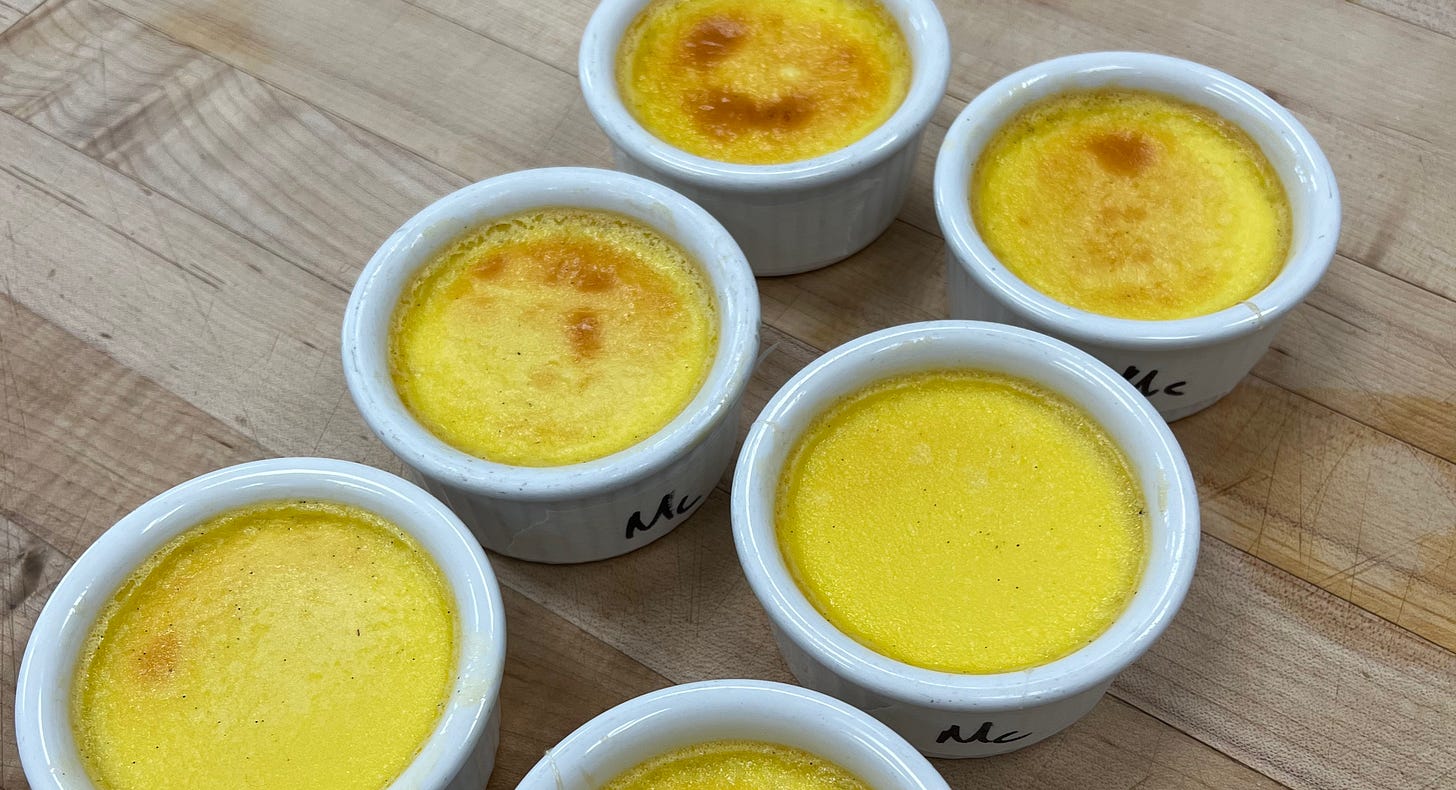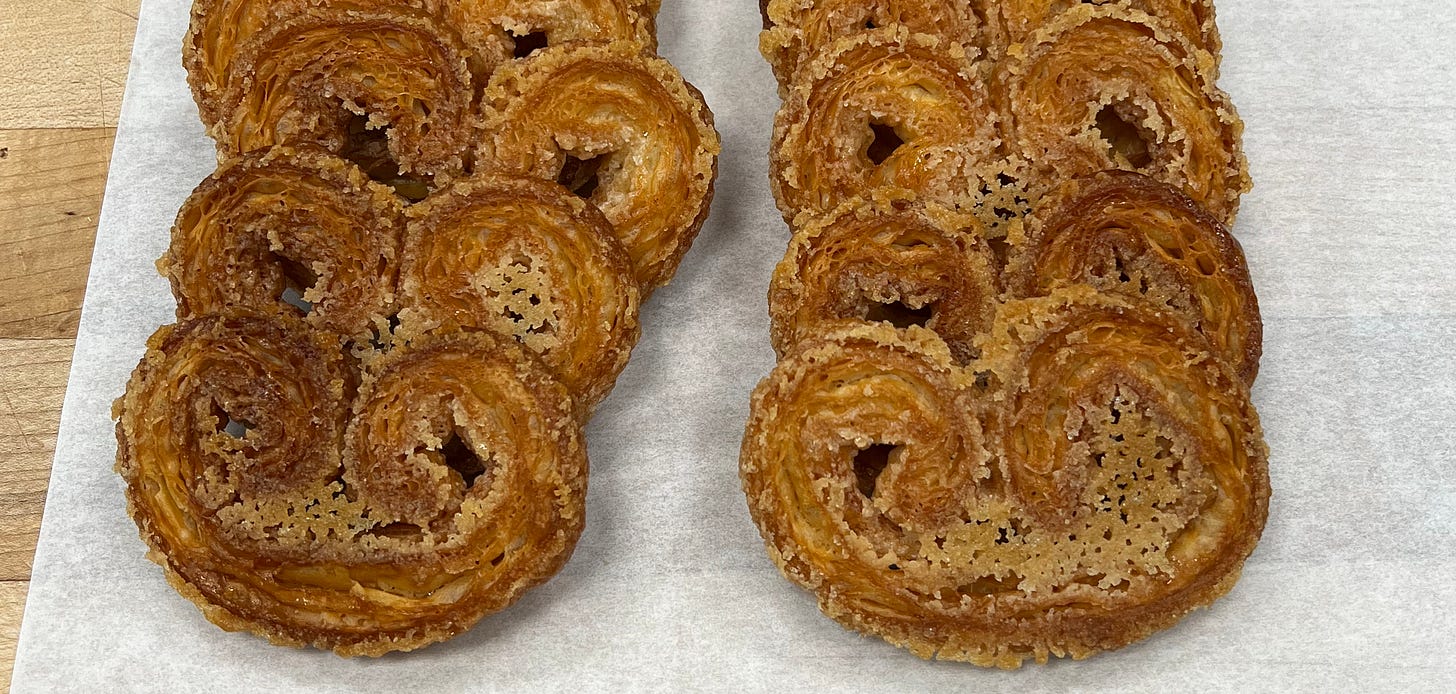Is there anything more “old money” than crème brûlée? Something about cracking into a caramelized sugar shell and scraping the perfect custard out of a white porcelain ramekin with a (preferably silver) spoon just screams “my other ride is a Rolls Royce chauffeured by a manservant named Egbert.” Or maybe that’s just how I feel given how much of a staple crème brûlée is at American steakhouses.
Either way, we made crème brûlée and puff pastry this week, and the results were excellent.
Crème brûlée
Crème brûlée turns out to be surprisingly finicky to make the “correct” way. The custard must be partially (but not completely!) cooked on the stovetop, the ramekins seated in a bain marie1 in the oven, the custard tested for doneness by examining them for a “slight shimmer”, etc. Even the fun part is difficult! The custard must be perfectly dry before adding sugar, the sugar sprinkled liberally but not too thick, and the blow torch held at just the right distance to caramelize but not scorch.
At least the day’s efforts were enlivened by Chef’s (almost certainly apocryphal) story of making crème brûlée for Julia Child when she was over 90 years old. Apparently, she off-handedly called it “the best crème brûlée I’ve ever had” and it led to a ten-fold increase in crème brûlée orders, much to the chagrin of the pastry chefs.
Crème caramel
Next up were creme caramels — basically flan that sauces itself(!!) with a layer of caramel underneath it. These jiggly parcels are so luscious, plus the absolute sheer joy of turning them upside down and watching the caramel pour over a little mound of flan is just the pick-me-up I needed after the tricky brûlées.2
Mille Feuille
I had never heard of mille feuille before, but they are a pastry/cake/snack thing made from layers of puff pastry sandwiched with pastry cream and topped with fondant icing feathered3 with chocolate. Here’s an example of what a professional version would look like, and I felt like I got surprisingly close for a first attempt! This was an absolute mess to eat, but it’s hard to go wrong with puff pastry and cream.
Palmier
I had definitely seen these French cookies made from puff pastry before and had no idea they are so easy to make! You just paint some puff pastry dough with simple syrup, sprinkle over an unholy amount of sugar, roll them into their characteristic shape, and slice orthogonally. These are so crisp and flaky and not-too-sweet (shocking given how much sugar goes into them). Chef gave me compliments on my bake (most students took them out too early, so they were missing the rich, golden color)4 and I was delighted when Mabel happily munched on one of these for her afternoon snack.
Cremeux
We made a delicious chocolate pudding called cremeux (apparently it’s also used to filled eclairs…more on that later). I am not ashamed to admit that I consumed this entire bowl of cremeux. I am ashamed to admit that I did so in a single sitting with a spoon.
Pavlova?
Finally, Chef said we would be making a “modern interpretation” of a pavlova. First, we created meringue tart shells (technically called “vacherines”) by piping circles of meringue on top of one another and baking them at a low temperature (175˚F) for over an hour. Then, we took some of our cremeux and folded in whipped cream to create a chocolate quick mousse. Finally, we topped the whole thing with fresh fruit. I’ve never heard of a pavlova that involved chocolate, but I can say that this creation was delicious.
A bain marie is just a water bath but it literally means “Marie’s bath” in French. Chef thought this was endlessly entertaining and kept making jokes along the lines of “I don’t know who Marie is, but everyone wants to get into her bath.” Actually, it turns out it’s “Mary’s bath” and she was apparently a jewish alchemist from the 4th century AD, but that’s a story for another time.
It’s incredibly annoying having to type all those accents every time I write “crème brûlée”
I feather things now! Look at me!
According to Chef, Americans have a general aversion to any color in their baked goods, and this is the source of many problems in American pastry cooking









